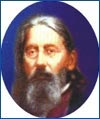Common Life Everlasting. Composita.
A fragrant, bitterish, aromatic annual, growing in fields and woods ; flowers in summer and autumn.
Tincture from the fresh
plant, chopped and pounded to a pulp.
Provings by Banks,
Fuller and Woodbury. See Allen’s Encyclopedia, vol. 4, p. 456.
CLINICAL AUTHORITIES.
– Sciatica, Cate, Raue’s Rec., 1874, p. 261 ; Dudley, McCourt, Trans. Hom. Medorrhinum Soc. Penna., 1882, p. 161.
SENSORIUM.
Giddiness, especially after rising from recumbent
position.
INNER HEAD.
Fulness about temples.
Dull, continuous pain in back of head, with shooting pain in
eyeballs.
FACE.
Dull, heavy expression ; face appears bloated.
Neuralgic pain, of an intermittent form, of superior maxillary of
both sides.
TASTE, SPEECH, TONGUE.
Flat, sweetish, sickening taste in mouth.
Tongue covered with long, white fur.
INNER MOUTH.
Mouth feels parched and tastes badly.
HICCOUGH, BELCHING, NAUSEA AND VOMITING.
Flatus of stomach, windy eructations, nausea and
hiccough.
ABDOMEN AND LOINS.
Colic pains in various parts of abdomen, which is sensitive to pressure, in cecum.
Borborygmus, with emission of much flatus.
STOOLS AND RECTUM.
Rumbling in bowels with stool before breakfast.
Looseness of bowels, with passage of pale-colored feces.
Diarrheic discharges in morning and during day, with irritable temper ; pains in bowels in children.
Copious, watery stool at night, with much prostration, nausea, pain and rumbling in bowels.
Dark-colored, liquid, offensive stool in morning, afterwards pain in bowels all day.
Vomiting and purging, like cholera morbus, in the night and all next day.
Constipation for three days after the diarrhoea.
URINARY ORGANS.
Pain in kidneys, with frequent slight pain in prostrate gland.
Sensation of fulness and tension in bladder, even when just emptied.
MALE SEXUAL ORGANS.
Increase of sexual passion, waking with an erection and urgent desire for an embrace ; the desire was rather mechanical than passional.
Irritation of prostate gland.
INNER CHEST AND LUNGS.
Pains in chest, darting from side to side.
NECK AND BACK.
Numbness of lower part of back, with lumbago.
Sensation of weight in pelvis.
UPPER LIMBS.
Feeling of debility in arms, with rheumatic pains.
LOWER LIMBS.
Pains dull or darting, or cutting from right hip-joint posteriorly downward to foot ; < lying down, from motion, stepping ; > sitting in chair.
Intense pain along sciatic nerve, following its larger ramifications.
Sciatica.
Feeling of numbness occasionally taking place of sciatic pains, making exercise very fatiguing.
Rheumatic pains in knee and ankle-joints.
Frequent cramps of calves of legs.
Cramps of feet in bed.
Gouty pains in big toes.
REST, POSITION, MOTION.
Lying down : pain from hip-joint to foot <.
Sitting in chair : pain from hip-joint to foot >.
After rising from recumbent position : giddiness.
Motion : pain from hip-joint to foot <.
Stepping : pain from hip-joint to foot <.
Exercise very fatiguing : from numbness in lower limbs.
TIME.
Morning : diarrheic discharges ; dark-colored, liquid, offensive stool.
During day : diarrheic discharges ; pain in bowels.
Night : copious, watery stool ; vomiting and purging.
ATTACKS, PERIODICITY.
Intermittent : neuralgic pains in face.
Three days : constipation.
LOCALITY AND DIRECTION.
Right : dull, or darting, or cutting pain from hip-joint to foot.
SENSATIONS.
Pain : in bowels ; in kidneys ; in
prostate gland ; in chest.
Intense pain : along sciatic nerve.
Cutting pain : from right hip-joint to foot.
Darting pains : from side to side in chest ; from right hip-joint to foot.
Shooting pain : in eyeballs.
Neuralgic pain : of superior maxillary.
Gouty pains : in big toes.
Rheumatic pains : in limbs ; in knees and ankle-joints.
Colic pains : in various parts of abdomen.
Cramps : of calves of legs ; of feet.
Dull, continuous pain : in back of head, from right hip-joint
to foot.
Lumbago.
Irritation : of prostate gland.
Weight : in pelvis.
Fulness : about temples ; in bladder.
Tension : in bladder.
Debility : in arms.
Numbness : of lower part of back ; in limbs.
TOUCH, PASSIVE MOTION, INJURIES.
Pressure : abdomen sensitive.
RELATIONS.
Compare : Anis. stel., Chamom., Ipecac., Mercur., Pulsat., Xanthox.
“NOTE:
PLAIN TEXT : LOWEST & DESIGNATES AN OCCASIONALLY CONFIRMED SYMPTOMS;
Plain blue: MORE FREQUENTLY CONFIRMED;
BOLD BLUE : SYMPTOMS VERIFIED BY CURES;
BOLD RED : REPEATEDLY VERIFIED;
$BOLD ITALIC RED$ : AN APPROVED CHARACTERISTIC;
θ : STANDS BETWEEN CURED SYMPTOM & PATHOLOGICAL CONDITION;
** : OBSERVED FROM OLD SCHOOL OR NEW SCHOOL;
toxic : Toxicology;
r : Right;
l : Left;
< : Increased or aggravation;
> : Decrease or amelioration;
^^ : Symptoms observed only on the sick “

